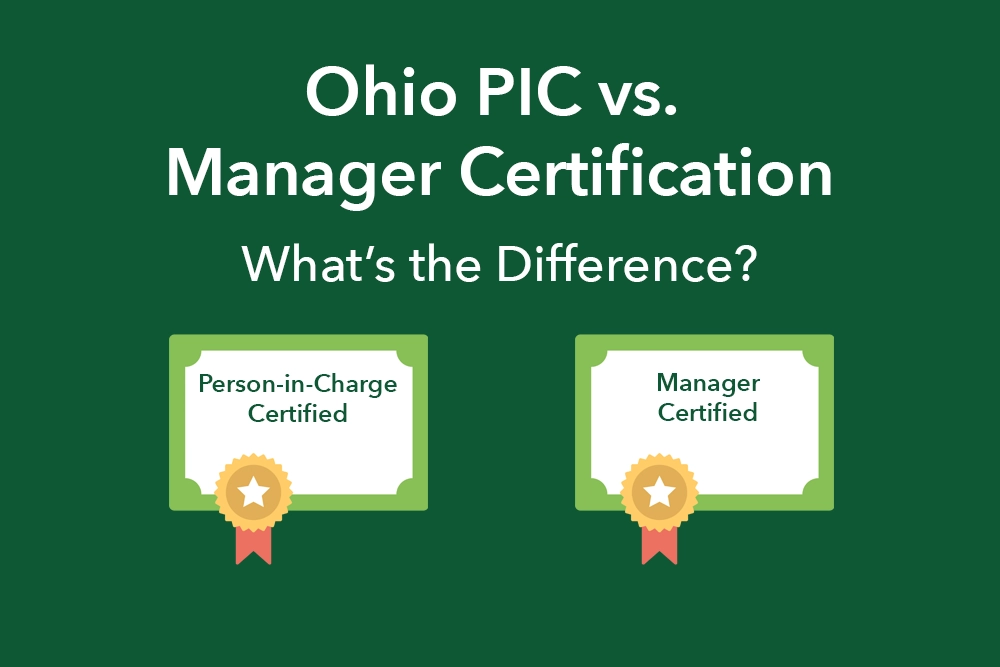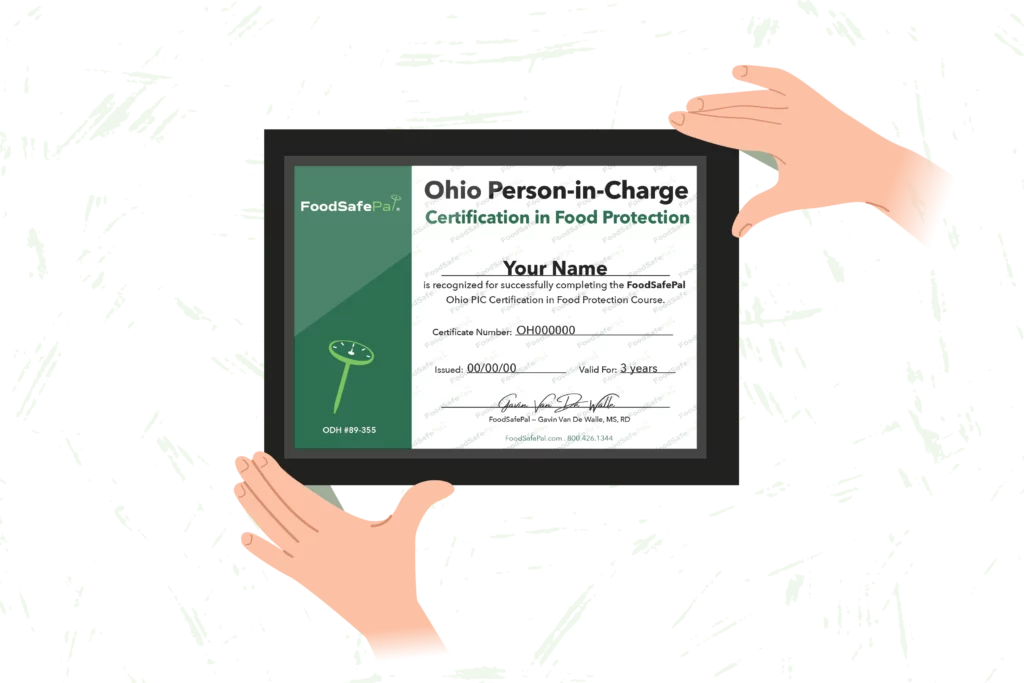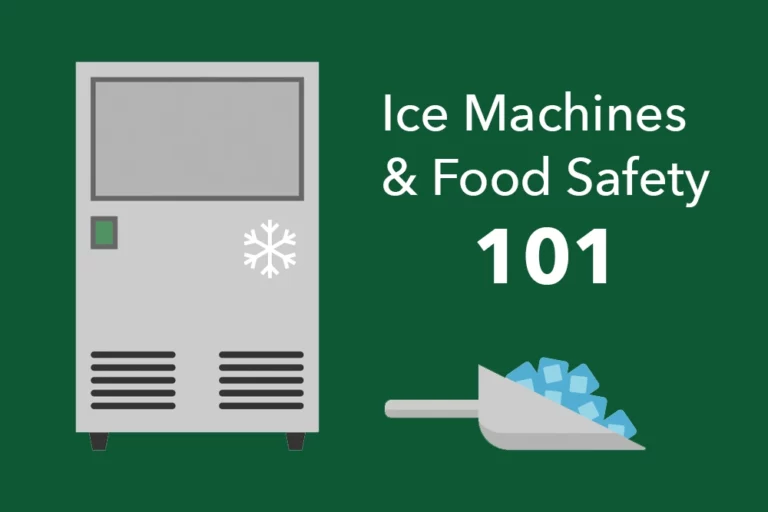Ohio Person-in-Charge vs. Manager Certification: What’s the Difference?
Article Summary
Ohio requires food safety certification based on your role. The Person-in-Charge (PIC) certification covers basic food safety for shift leads, while the Manager certification is for those who oversee staff or higher-risk operations. Both must be earned through an Ohio Department of Health–approved provider like FoodSafePal, which offers both courses online.
If you work with food at your job, you’ll likely need some type of food safety certification.
In Ohio, there are two options: person-in-charge (PIC), formerly known as level one, and manager, formerly level two.
This article breaks down the key differences between the two so you can figure out which one you need — and how to get it.

What is the person-in-charge (PIC) certification?
In Ohio, the person-in-charge (PIC) certification — formerly called level one — is a food safety training required for someone on every shift at most food establishments.
The requirement applies to food service operations and retail food establishments classified as risk level I, II, III, or IV — unless the designated person already holds a valid manager certification. Here’s how Ohio defines each risk level:
- Risk Level I – Lowest risk. Includes operations that sell only prepackaged, non-time/temperature controlled foods or drinks.
Examples: convenience stores, micro markets, self-serve drink stations - Risk Level II – Slightly higher risk due to employee handling. Minimal chance of bacterial growth.
Examples: reheating packaged food for immediate service, hand-dipping ice cream, selling hot dogs from a roller grill - Risk Level III – Higher risk from cooking, holding, or cooling foods.
Examples: pizza shops, sandwich shops, fast-casual restaurants preparing meals on-site - Risk Level IV – Highest risk due to reheating leftovers, serving high-risk populations, or using specialized processes.
Examples: school cafeterias, nursing homes, hospitals, caterers
PIC certification is also required if:
- The establishment was licensed after March 1, 2010
- The operation was involved in a foodborne illness outbreak
- A licensor documented unsanitary or unsafe conditions
The goal of the PIC certification is to ensure that someone on each shift understands and applies the basics of food safety, including safe food handling, handwashing, temperature control, and cleaning procedures.
To earn PIC certification, you must take a course approved by the Ohio Department of Health. Not every food safety course qualifies — only those that have gone through the state’s official review process.
FoodSafePal is one of those approved providers.
What Is the manager certification?
The manager certification — formerly called level two — goes a step further. This training is meant for someone who oversees food prep and has the authority to train staff, enforce procedures, and make changes when needed. If you’re the one in charge of food safety decisions, this is the certification you need.
It’s required for at least one person at every risk Level III or IV establishment. That includes:
- Full-service restaurants where staff cook, cool, and hold food for later use
- Schools or hospitals that reheat bulk leftovers or serve high-risk populations
- Catering businesses or any operation using complex prep methods or HACCP plans
The manager certification provides more in-depth training than the PIC certification and is intended for those who oversee food safety procedures, train staff, and have the authority to make operational changes when needed.
To earn manager certification in Ohio, you must complete both:
- An approved training course, and
- A separate ANSI-accredited exam
These are not bundled by default, and the exam is not based on any specific course, but the training prepares you for the food safety principles the exam covers.
As with PIC, only courses reviewed and approved by the Ohio Department of Health meet the requirement.
How to get certified
Whether you need PIC or manager certification, here’s how to go about getting it.
How to get PIC certified
To earn Ohio PIC certification, you must take a course approved by the Ohio Department of Health. These courses cover essential food safety topics like preventing cross-contamination, proper handwashing, temperature control, and cleaning practices — all aimed at reducing the risk of foodborne illness during day-to-day operations.
Only providers that have been reviewed and approved by the state are accepted. That means not every online food safety course will meet the requirement, even if it looks official.
FoodSafePal is an approved provider. The course takes about two hours to complete, is entirely online, and meets all Ohio requirements. There’s no exam, and certification is guaranteed once you finish the training. Your certificate is valid for three years and available to download immediately.

Get Your Ohio Person-in-Charge Certification in Food Protection
No Final Exam. Certification Guaranteed.
How to get manager certified
To earn Ohio manager certification, you must complete an approved training course and pass an approved exam
The training must come from a provider approved by the Ohio Department of Health, and the exam must meet ANSI accreditation standards. While the exam isn’t based directly on the content of any specific course, it tests your understanding of the same core food safety principles.
The course helps prepare you for the concepts that appear on the exam, but passing the test ultimately depends on your grasp of those concepts.
FoodSafePal’s manager-level course is approved by Ohio, and its ANSI-accredited exam will be offered in October 2025.
The bottom line
Ohio requires food safety certification based on the type of work you do and the level of risk at your establishment.
If you’re responsible for food safety during a shift, the PIC certification is likely what you need — and you can complete it online through an approved provider like FoodSafePal.
If you oversee food preparation or manage staff at a higher-risk facility, you’ll need both an approved manager-level course and a separate exam. Not all courses meet Ohio’s requirements, so be sure to choose one that’s been reviewed and approved by the Ohio Department of Health.

Get Your Ohio Person-in-Charge Certification in Food Protection
No Final Exam. Certification Guaranteed.






